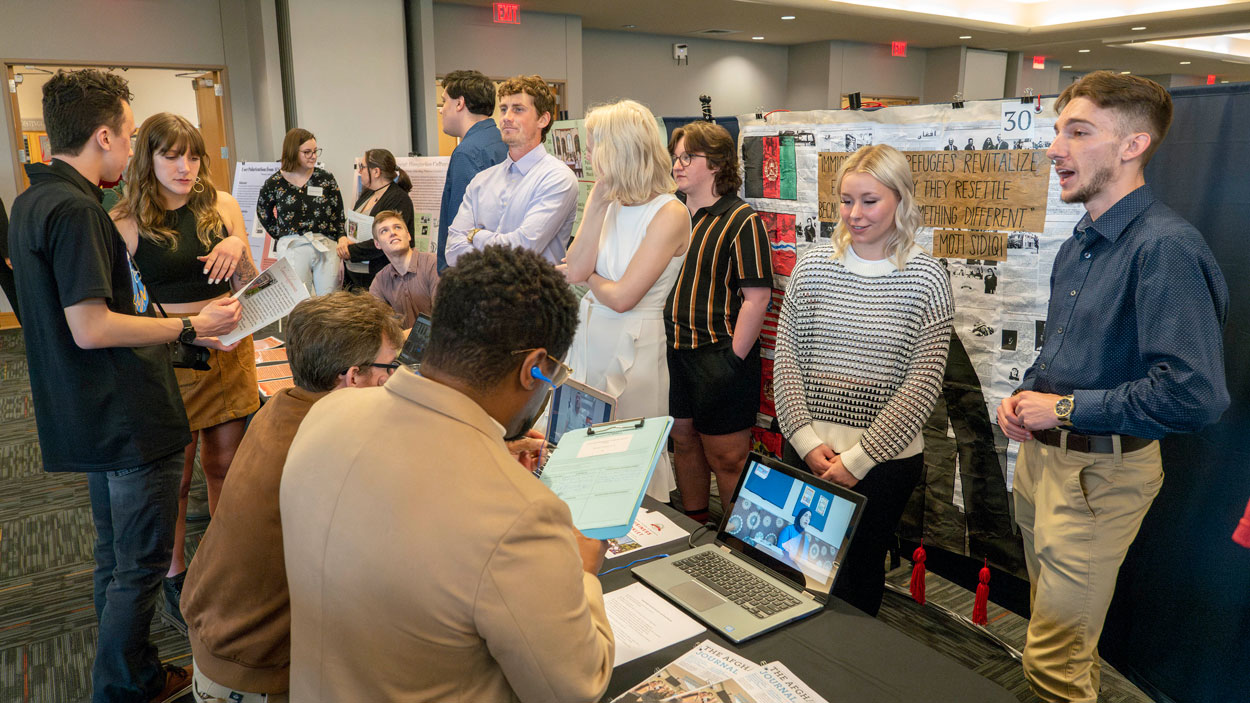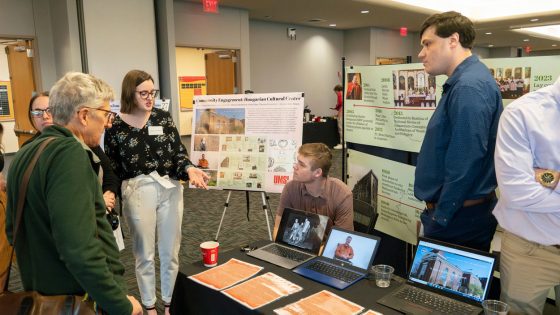
Students in the “Beyond the Buildings” course, offered in the Pierre Laclede Honors College, present their projects at the Undergraduate Research Symposium on April 26. (Photo by Derik Holtmann)
When Michael Raffelson first toured the St. Mary of Victories Catholic Church with congregants Jim and Lisa Hooper, he was struck by the amount of knowledge and compassion the duo shared for St. Louis’ Hungarian Catholic Church and cultural center. Over the course of two hours, he chatted with them and looked through old photographs to learn more about the history of the church and its significance for the Hungarian community in St. Louis.
Raffelson, who graduated from the University of Missouri–St. Louis this month and will be pursuing his MPPA this fall, was inspired. For his final project in the “Beyond the Buildings” course in the Pierre Laclede Honors College, he revitalized the website for St. Mary of Victories, adding new pages including info on mass times and events as well as background on the history of the church. He hopes the new website helps visitors better understand how important the church is to the community.
“In the age of social media, in the digital world we live in, I wanted to be able to show the compassion and the knowledge that Jim and Lisa shared with me,” Raffelson said. “They just showed the passion and the knowledge that they had for the church and the surrounding community and the importance it had to them. And I wanted to make sure and format a website where that compassion and that knowledge comes through.”
The “Beyond the Buildings” course encourages students to get outside the classroom walls and engage directly with local partners throughout the community. While the course previously centered on local municipalities, Rob Wilson, assistant teaching professor and community engagement coordinator in the Honors College, restructured it this semester to focus specifically on immigrant communities. In addition to the St. Mary of Victories Catholic Church, students also worked closely with the Afghan Community Center and Afghan Chamber of Commerce.
“We’ve met these people where they are and that’s important because students realize just how important this work is and how meaningful it is to other people,” Wilson said. “The students are also gaining skills that are very marketable; it’s really developing their leadership skills and communication skills and exposing them to areas of St. Louis and to different communities they never would have been exposed to before.”

Students came up with projects to suit the needs of the St. Mary of Victories Catholic Church, Afghan Community Center and Afghan Chamber of Commerce, including resource pamphlets, newsletters, artwork and a cookbook. (Photo by Derik Holtmann)
Over the course of the semester, students collaborated with the organizations to develop projects based on their needs, including resource pamphlets, newsletters, artwork and even a cookbook. Students Emily Jesse and Rae Cohen produced a traditional Hungarian cookbook, “Maté Makes Meals,” while Theresa Colombini, who is studying international relations and marketing, created a new timeline to hang up in the Hungarian cultural center.
Several students also produced oral history videos with members of the Hungarian community in St. Louis. Cohen, John Granicke and Colin Ring interviewed Mike Futo, whose father, Albert, immigrated to the U.S. during the Hungarian uprising of 1956. In the video, Futo shares his father’s journey from escaping communism to landing at the St. Mary of Victories Catholic Church and the role that the church played in his life in St. Louis.
“When making this video, we got to sit down with Mike, we got to listen to his story, and really experience firsthand his childhood growing up in St. Louis being part of the community of St. Mary of Victories,” Granicke said. “And with creating these videos, we get to record that, and even if the building for St. Mary of Victories is actually torn down one day, this video will live on forever. We can publish it online and share it with future generations. So, it’s a really cool thing to do.”
Ring added: “Interviewing Mike gave me new perspective on the emotion behind having to leave Hungary and how much St. Mary of Victories meant to the Hungarian community in St. Louis by allowing them to still be able to be around Hungarian culture.”
Students Skylar Baxter, Nick Black, Mason Clynes, Vince Costa, Lauren Graf, Liv Klein, Ashley Maempa and Tyler Winter also collaborated to produce an issue of The Afghan Journal, a newspaper that aims to connect, celebrate and empower the Afghan community in St. Louis. Students wrote all of the stories, including articles on Afghan history, immigration to St. Louis, Afghan restaurants in St. Louis and a local organization helping refugees, and Costa formatted and designed the issue.
Black and Graf also put together two booklets for Afghans living in St. Louis, featuring resources such as educational services, health services, community organizations and housing services as well as a guide to Afghan-owned businesses in St. Louis.
“The reason we wanted to focus on those specifically is to bring more Afghan immigrants to the St. Louis area, and by sort of highlighting a bunch of Afghan businesses in the area, it provides a sense of comfort and familiarity that these immigrants can hopefully come to St. Louis and feel safe and actually engage with the community more,” Black said.
“We spent a good amount of time actually going to each of these businesses off of South Grand and speaking with the Afghan owners,” Graf added. “I think it was really interesting and neat to actually sit down and speak to them and hear about their experiences obviously being an immigrant and then also hearing about what it means to own their own business and entrepreneurship in St. Louis. And a lot of them are dedicated to just community in general and uplifting other refugees.”
In addition to their individual projects, students also wrote 800- to 900-word blog posts on different immigrant groups that will be posted on the website of the International Institute of St. Louis and UMSL’s Digital Humanities site. Wilson hopes the students’ work this semester will have an impact that reaches far beyond the classroom.
“I think it’s important that they realize why history is important and what it can do for the community,” Wilson said. “When you take a traditional class, you turn in your essay or your research paper and you get a grade on it. It’s not like that in this class. They’re actually showing stuff to the committee members, and it’s really empowering them. There’s a sense of pride, of accomplishment and sense of meaningfulness in the work they created.”














